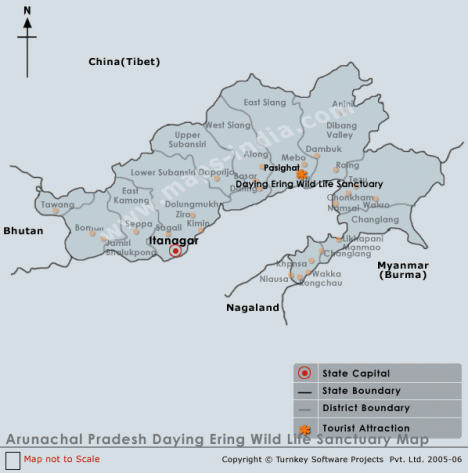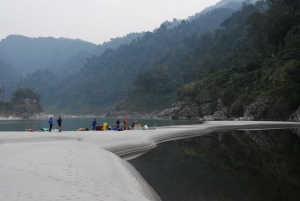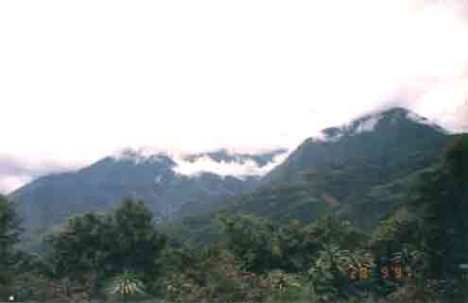Attracting tourists from far and wide with its scenic splendors, Pasighat is one of the famous hill stations of the state of Arunachal Pradesh. Established in the year 1911, it is the oldest town of the state. Popularly known as the ‘gateway of Arunachal Pradesh’, this town got its name from Pasis, one of the tribes still inhabiting the state. Hemmed in by enchanting hills, the town also boasts of gorgeous green river valleys. The picturesque landscape of Pasighat allures many a tourist from far and wide.
Pasighat is affectionately dubbed as a ‘photographer’s delight‘ as it offers breathtaking views of nature. The enchanting Brahmaputra river flows through this town, adding more beauty to it. This hill station also serves adventure in plenty.
North East India region is a wonderful tourist destination encompassing eight beautiful states. Arunachal Pradesh is one of them and is well known for its fascinating hill stations such as Pasighat. Pasighat attractions include scenic beauty and adventure sports. Plan a North East India Trip and explore the wonderful Pasighat.
Daying Ering Wildlife Sanctuary
State : Arunachal Pradesh, the north eastern state of India.
Best time to Travel : December To February.
Location : The sanctuary is located at East Siang District, covering an area of 190 sq. km.
Know Daying Ering Wildlife Sanctuary (Arunachal)
Daying Ering Memorial Wildlife Sanctuary in Arunachal Pradesh has all the necessary character to approve a strong eco-tourism sector. The Daying Ering Wildlife Sanctuary Arunachal Pradesh covers a total area of 190 sq km. The major part (75%) of the Daying Ering Wildlife Sanctuary is formed by an alluvial grasslands, wooded areas constitute about 15% and the rest is water.
The Arunachal Pradesh Siang River (Brahmaputra in Assam) surrounds the northern, eastern and western parts of the Arunachal Pradesh Daying Ering Wildlife Sanctuary.
The southern part of this sanctuary extends into the adjoining state of Assam where it is called Kobo Chapori.
Located 13 km from Pasighat, the Daying Ering Wildlife Sanctuary is a series of river islands. The extraordinary ecosystem of water bodies is home to thousands of migratory birds from Siberia and Mongolia and is of interest to the amateur and the serious ornithologist alike.
Journey to Daying Ering Wildlife Sanctuary (Arunachal Pradesh)
Airport : Mohanbari is connected to Delhi and Kolkata via Guwahati. From Mohanbari one can reach Pasighat by Pawan Hans Helicopter Service on schedule days.
Railhead : Murkong Selek (Jonai), Assam (65 KM away from the Pasighat) is the nearest railhead from the sanctuary.
Road Transport : NH-52 connects Pasighat with the rest of the country. Daily bus services are operated by the State Transport Department, Govt. of Arunachal Pradesh from Itanagar – along, Yingkiong.
Water Transport : Daily boat services are available from Dibrugarh to Oiramgaht from where one can reach Pasighat by local bus (25 km from Pasighat).
Staying near Daying Ering Wildlife Sanctuary
Mr. Taching Sitang Eko Siang Guest House and Circuit House DFO Wildlife are some of the accommodation facility for the tourists to stay.
The Ecosystem of the Sanctuary
Daying Ering Wildlife Sanctuary exhibits a diversity of habitats. The area holds important communities of plants and animals and together forms an ecosystem, which is unique and rare.
The Birds
The Daying Ering Sanctuary is home to a large number of endangered aquatic birds, namely, bear’s pochard, Indian skimmer, spot-billed pelican, lesser adjutant, lesser whistling teal, black-bellied tern and the darter. It is also a staging site for migratory birds and has some of the largest concentrations of waterfowl in Arunachal Pradesh, especially in winter.
Daying Ering Memorial Wildlife Sanctuary has also recorded varied woodland birds, notably, globally threatened species like the Bengal florican, swamp francolin, black-breasted parrot-bill, Pallas sea eagle and others.
The Reptiles
Having a relatively large area under water, the sanctuary has rich potential for the development of fishery. The waters of the Siang River harbor a large number of species (more than 100) of Pisces turtles, water monitor lizards and reptiles. Gangetic dolphins have also been recorded.
The Fauna
The grassy and forested islands are home to deer, wild buffalo, elephants and other rain forest species. The lucky may also catch a glimpse of the Tiger. The sanctuary’s woodlands are an ideal habitat for a host of species like the leopard, civet cat, leopard cat, sambar, barking deer, hog deer, rhesus macaque, wild boar, porcupine, stripped squirrel, pangolin, jackal, python and other animals.
The sanctuary offers a congenial habitat to migratory elephants due to its savannah type of grasslands. The main attraction of the sanctuary is the mesmerizing waters of the Siang River (sknown as the Tsangpo in Tibet and the Brahmaputra in Assam). With its river islets, it offers a spectrum of attractions for adventurers and eco-tourists.
Other Activities near the Sanctuary
Wildlife viewing, river cruises, water recreation, white water sports (kayaking, rafting, para-sailing and so forth), angling, bird watching, ethno-botanical walks, herbal trails and study of its flora and fauna are the main attractions and potentials of the sanctuary. Pitcher plants are also spotted in the sanctuary.
Siang River, Pasighat, Arunachal Pradesh, India
INTRODUCTION
Siang River in Arunachal Pradesh is a part of the great Brahmaputra. Siang River enters India in the Upper Siang District of Arunachal Pradesh. The River is known to have its origin in China and offers one of the premium wilderness expeditions in the world.
Siang River valleys and tributaries are the home of the Adi people of Arunachal Pradesh. The Siang River offers ample opportunities for adventure sports like river rafting, angling, and trekking. A hanging bridge on the Siang River is an interesting sight to be seen. The bridge made of cane and bamboo is around 60 to 70m long, connecting the hill tribal settlements. The river Siang is known as Brahmaputra in Assam. The Brahmaputra is the confluence of Siang and Lohit rivers of Arunachal Pradesh.
Dr.Daying Ering Memorial Wildlife Sanctuary in Arunachal Pradesh is surrounded on the northern, eastern and western sides by the Siang River.
Special features of the Siang rivers are :-
RAFTING AND KAYAKING SPORTS
Opened to foreign travelers in only 2003, the Siang remains one of the least explored gorges on the planet to anyone – other than the 100,000 Adi who inhabit the corridor, which sustains the last surviving rainforest in India. The Adi subsist much as they have for thousands of years in the steep, forested Siang River Valley, and lodging in picturesque bamboo, cane, and thatch homes, which dot the landscape. Siang River is among the best River considered for rafting and kayaking in the whole planet, Siang River is complete free from Industrial pollution and is absolutely most favorable for summer rafting and Kayaking.
KEKAR MONYING:
A mountain cliff near Rottung is an important historical place because it was here that the Adi put up a strong resistance against the British in 1911. The war was a part of a punitive expedition undertaken by the British for murdering Noel Williamson, a political officer in the previous year by Matmur Jamoh, a native of Yagrung village.
Komsing, a village on the left bank of the Siang is the place of Williamson’s murder. A stone epitaph bearing the name of Noel. Williamson still lies near the Siang. GOMSI, a cultivation area near Rani village is another place of historical importance. In June’96 a team of archaeologists led by Shri T. Tada, Deputy Director, Archaeology of the Research Department conducted a trial excavation and survey in the site. They have found apart from broken pieces of different evidence of glorious past culture of early medievarrl period (probably Pre-Ahom).
The site has a big rectangular Canal measuring 3.5 meters wide and a pond measuring 38×36 mts. in the site. A mound has been unearthed inside the Canal area from where 13 different sizes of bricks have been found from it’s brick wall.
Further excavation and extensive study is required to arrive at a definite idea about the 11.5 acres big settlement area
PANGIN
situated at a distance of about 60 kms. from Pasighat, and connected by road, it atands at a point where River Siyom meets River Siang and presents a rare sight. The blue waters of Siom meet the green Sinag and the beauty of the site is to be seen to be believed.
The locals still maintain their traditional Socio-cultural practices and observe different festival like Mopin, Solung, Unying-Aran, Etor, Pime, Ali-Aye Ligang etc. They use various colourful costumes and perform dances like Ponung, Delong, Gumrak Soman, Yakjong, Tapu and various other folk dances. They can be of additional aspects of interest specially for sociologists, anthropolog ists and other culture tourists.
ists and other culture tourists.
Other places of interest are Yambung, Boleng, Ranaghat at Pasighat, Rottung, Ayeng village on the left bank of the Siang, Balek, J.N. College, Craft centre, Pasighat and District Museum










It is most attractive place for tourist in India. We can find beauty of nature here very easily. If you are deciding to visit north east part of India then you must visit Bomdila in arunachal pradesh it will make your life comfortable and thanks for providing this types of information. Really it helps a people a lot.